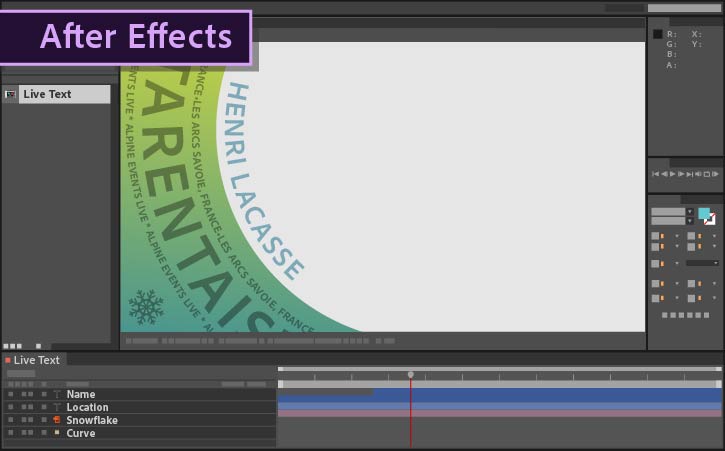- Triangle Up And Down In Premiere Pro After Effects
- Adobe Premiere Pro After Effects
- Premiere Pro After Effects Workflow
- How To Fix Audio In Premiere Pro After Effects
Cover image via
After Effects and Premiere Pro are two of Adobe’s flagship post-production apps. But which one do you need for which task? Let’s find out.
Premiere Pro is engineered to take advantage of the GPU. After Effects is also GPU-optimized. Graphics card with at least 4GB of memory (VRAM). (Optional) Multiple GPUs, including eGPUs, can be used to speed up rendering and export. Jan 28, 2021 Adobe announced it will be updating terminology across Premiere Pro, After Effects, and Audition to reflect their commitment in providing an inclusive toolset for all users. The first of these changes were implemented in the October 2020 release of After Effects and are now included in the Premiere Pro and Audition public Betas apps.
Better late than never, Adobe After Effects 18.0, Adobe Premiere Pro 15.0, and Media Encoder will now be able to import ARRI Alexa Mini footage! Also, Warp Stabilizer in Premiere Pro and After Effects should be up to four times faster in stabilizing UHD footage, according to Adobe. Creative workflows between Premiere Pro and Adobe After Effects; Use Live Text templates from After Effects in Premiere Pro. Edit After Effects work in Premiere Pro.
When you’re creating a new project, knowing when to use Premiere and when to use After Effects can make or break your project. They are both extremely powerful programs, that can sometimes perform the same functions, but most of the time, one of them is better at something than the other.


Now the differences between these two programs are pretty apparent to anyone who has used them before. But, if you’re new to the suite, it can be confusing determining which one you need to learn for a given post-production task.
Let’s take a look at Adobe’s two main video production software tools and see what they do — and when to use one over the other.
Adobe Premiere Pro
Triangle Up And Down In Premiere Pro After Effects
Adobe Premiere Pro is an NLE (nonlinear editor) with the main function of editing video clips together in a sequence. This is the program that most beginners open to create a simple video with multiple clips and music. It’s incredibly scalable — easy to use for beginners, and still powerful enough for a master editor. It’s got just about everything you need to complete a professional video: a clip editor, color correction tools, audio programs, and even graphics software.
Tasks for Premiere:

- Editing a video with existing clips imported from a camera.
- Editing audio within your video — Premiere’s audio functions far surpass AE’s.
- Placing transitions between clips within your timeline.
- Creating/polishing any type of video — short films, music videos, social videos, etc.
Adobe After Effects
Adobe After Effects is a digital motion graphics platform used to create either simple animations or intricate graphics sequences. If you ever hear of a “motion graphics expert,” chances are they’re proficient in After Effects. The program adds motion to layers and assets that you couldn’t do in Premiere. Its motion tools are much better than Premiere’s, and it’s the preferred tool for adding motion to videos, images, and designs. It’s a “hard to learn, easy to master” type of program, but once you get the hang of it, it’s essential for creating motion graphics or visual effects for your projects.
Tasks for After Effects:
- Creating motion graphics packages for your projects.
- Adding motion blur and movement to assets and layers.
- Manipulating multilayer sequences that require detailed keyframing.
- Creating title sequences that include keyframe-based animations.
After Effects Vs. Premiere Pro: What’s the Difference?
To sum it all up, Premiere assembles all of your assets and creates a final video product, while After Effects is mainly an asset-generation tool. People complete projects in After Effects all the time, though — it’s great for creating motion-based social video with only a song bed underneath, or even creating a full animation.
So really, there’s no true “vs.” in this argument. It’s kind of like debating PowerPoint and Word — you use them for different tasks, even though they share some similar functions. They are extremely well linked, though — and like many editors, I use them concurrently all of the time. Once you get familiar with both programs, you’ll learn how to dynamically link After Effects compositions to your Premiere projects so you can access both assets at the same time. (For more information about dynamic linking, check out the video by Justin Odisho above.)
Looking for more on Premiere and After Effects? Check these out.
This page is a companion document to the system requirements for Premiere Pro and After Effects. It provides additional information on system components and considerations for optimal performance.
Want a downloadable version of this document? Click here to download a PDF.
The four key variables for a great video production system are memory, storage, graphics, and your processor.
Memory
Professional video workflows rely on system memory. A good video editing workstation should have at least 32GB of memory— and as much as 128GB.
Adobe Premiere Pro After Effects
Storage/hard drives
Fast storage is critical for video production. Use solid-state NVMe or SSD storage. Unless you have a fast RAID array, spinning disks generally do not offer sufficient speed for HD and 4K video production.
The best way to achieve excellent performance (and to keep different types of files organized) is to spread the load between multiple drives. An optimal setup has three drives:
- System drive for OS and applications
- Drive for the media cache
- Media drive (or shared storage)

Only have two drives? Use a fast external drive for your media and Media Cache.
The media cache is where Premiere Pro stores accelerator files, including peak files (.pek) and conformed audio (.cfa). Premiere Pro can make thousands of call to these files every second). For more information, see Set Media Cache preferences.
- NVMe Flash memory drives with Thunderbolt 3.0 connectivity are excellent.
- SSD drives with USB 3.1 connectivity are also good - but have a 4TB limit.
Graphics
The GPU is used for onscreen rendering and export, priority areas for video production. Premiere Pro is engineered to take advantage of the GPU. After Effects is also GPU-optimized.
- Graphics card with at least 4GB of memory (VRAM).
- (Optional) Multiple GPUs, including eGPUs, can be used to speed up rendering and export.
Premiere Pro After Effects Workflow
Out-of-date graphics drivers are one of the most common causes of performance issues with video applications. For optimal performance, make sure you have the latest drivers for your GPU, including integrated Intel GPUs. For more information, see GPU and GPU Driver Requirements for Premiere Pro.
Processor/GPU
For CPUs, clock speed matters more for After Effects. Multiple cores have more impact for Premiere Pro. The sweet spot for running both applications is a fast CPU with 8 cores.
- Core i7 or Core i9 Intel processors or AMD equivalents are strongly recommended.
- Fast clock speed at least 3.2 GHz, or higher.
- 8 cores are ideal for Premiere Pro. The application can use more cores, but without significant added benefit. Depending on the task, Premiere Pro runs at 93-98% efficiency with 8 cores.
H.264 and H.265 (HEVC) are widely used capture formats for DSLRs, mirrorless cameras, action cameras, and phones. H.264 is also the preferred format for uploading to YouTube and social media sites. These compressed formats are well suited for capture and distribution, but they are processor-intensive for post-production.
If you work with H.264 and H.265, consider Intel Core i7 and Core i9 processors, which offer Quick Sync hardware acceleration, supported in both Premiere Pro and After Effects.
AMD and Intel Xeon processors work well for other formats, such as cinema camera formats, (such as RED, Sony Venice, ARRI) and broadcast formats (such as XDCam HD).
How To Fix Audio In Premiere Pro After Effects
Adding memory is the easiest and usually most impactful place to start if you want to upgrade your system to improve performance for both Premiere Pro and After Effects.
Upgrade Premiere Pro system in this order of priority:
- More RAM — up to 128GB if your motherboard supports it.
- A faster GPU (or additional GPUs) for faster rendering and export
- Faster (or more) NVMe or SSD drives
- Faster CPU
Upgrade your After Effects system in this order of priority:
- More RAM — 128GB is a good target for top-of-the-line systems.
- Faster (or more) SSD or NVMe drives
- Faster GPU (or additional GPUs) for faster rendering and export
- Faster CPU
Export times are impacted both by your graphics hardware and your workflow. A second GPU (same class GPU as the primary GPU) can provide substantial speed increases for export. Creating previews during your edit can also accelerate export times.
Assuming you have a good system, performance for multicam workflows is more dependent on your project setup than your hardware. Expert users create their own project templates to standardize their setup.
A calibrated reference monitor connected through external transmit hardware is highly recommended for accurate display of interlaced and color critical content. Proper monitoring of HDR content requires an HDR-capable external display.
This is a matter of personal preference. Because the timeline is a central element in the Premiere Pro UI, an ultra wide 37” display combined with a second reference monitor is an excellent option.
Simultaneous monitoring of multi-channel audio requires a multi-channel sound card. On Windows the sound card should be ASIO-capable.
Your workflow, and how you decide to work with file formats, can have a significant impact on overall performance. Our best practices guide for working with native formats has suggestions for designing your workflow to ensure optimal performance with your hardware.
- Puget Systems recommendations for Premiere Pro
- Puget Systems recommendations for After Effects
